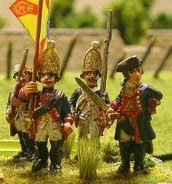 This is a photo of the table before the game. The Prussian Advanced Guard division is waiting to be deployed, as are the initial French on-board forces. The French deployment zone is marked by the red cord on the tabletop. Not shown in my earlier post about the terrain are the flocked wooded areas and some new 15mm trees I scratch-built for the game unsing my laser and some Woodland Scenics foliage clusters.
This is a photo of the table before the game. The Prussian Advanced Guard division is waiting to be deployed, as are the initial French on-board forces. The French deployment zone is marked by the red cord on the tabletop. Not shown in my earlier post about the terrain are the flocked wooded areas and some new 15mm trees I scratch-built for the game unsing my laser and some Woodland Scenics foliage clusters. French turn one. The on-board French (mostly the Italian division) forces have deployed along the Agger. Just arriving on the table are the first divisions of the Saxon corps.
French turn one. The on-board French (mostly the Italian division) forces have deployed along the Agger. Just arriving on the table are the first divisions of the Saxon corps.Visible behind the ridge running eastward from Dennewitz are the forces of the Prussian Advanced Guard.


A couple of turns later, the armies are continuing to deploy and troops are starting to form up (becoming stationary in Volley & Bayonet terms). Clear battle lines are beginning to become visible. Prussian reinforcements are marching to the position of the Advanced Guard who have taken up a defensive position on the heights opposite of the Agger. Artillery fire between the Advanced Guard and the Italian division has begun but has yet to cause significant casualties on either side.
 This is a close-up of the area around Dennewitz at about turn three or four. The brown pipe-cleaner markers denote troops that are stationary in Volley and Bayonet. For those unfamiliar with these rules, this is the highest state of order and represents a brigade that is formed and prepared to defend against attack through ranged or melee combat. Visible at the bottom-right of the screen are brigades of my new Saxon corps. At the very top of the screen, the Italians have sent a solitary brigade across the Agger to attempt to turn the Prussian left flank.
This is a close-up of the area around Dennewitz at about turn three or four. The brown pipe-cleaner markers denote troops that are stationary in Volley and Bayonet. For those unfamiliar with these rules, this is the highest state of order and represents a brigade that is formed and prepared to defend against attack through ranged or melee combat. Visible at the bottom-right of the screen are brigades of my new Saxon corps. At the very top of the screen, the Italians have sent a solitary brigade across the Agger to attempt to turn the Prussian left flank. Late in the battle Ralph (Speedo) Gero checks to range in his artillery on the Prussian lines. Other Volley & Bayonet mailing list members visible are me (behind the soda bottle with AJ on my shirt) and Ed Mueller (left checkered shirt).
Late in the battle Ralph (Speedo) Gero checks to range in his artillery on the Prussian lines. Other Volley & Bayonet mailing list members visible are me (behind the soda bottle with AJ on my shirt) and Ed Mueller (left checkered shirt).Visible at the bottom of the screen on the ends of both lines (marked with red markers) are the permanetly-disordered troops which were the result of the earlier Prussian cavalry charge on the French left flank. At the top of the screen you can see that the Prussian Advanced Guard has retreated to the reverse slope of their ridge after the French and Italian artillery had finally ranged in and started to inflict significant casaulties.
Soon after this photo was taken the game wound to a close with each army ready to fight another day of battle, but with us running out of time in the evening. Both sides did a great job of caring for their armies while deploying under fire. The first day of battle was fought to a draw.











